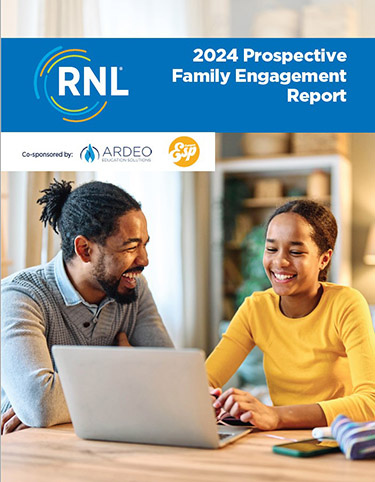enrollment
The Hidden Crisis in College Planning: What’s Happening to Middle-Income Families

Approximately 7-8 million families with school-age children are in the middle-income bracket ($60,000-$200,000). That’s not just a statistic—it’s a massive segment of your potential student population caught in a precarious position.
According to recent Census data, these families make up about 40% of all U.S. households, with 39% of family households including children under 18. They’re too “wealthy” for significant financial aid but not wealthy enough to write a check without breaking a sweat. Understanding this demographic isn’t just important—it’s crucial for the future of higher education.
Data from the 2024 Prospective Family Engagement Report from RNL and CampusESP reveals critical insights about this demographic that could reshape how we approach recruitment, financial aid packaging, and communication strategies.
The data that should change your strategy
Let’s start with the numbers that matter. Among middle-income families:
- 71% report loan concerns actively impacting college selection.
- 69% eliminate institutions based on sticker price before engaging.
- 60% find financing “difficult” or “very difficult.”
- 87% rank financial aid among their top five decision factors.
For enrollment managers, these statistics represent more than just data points—they signal significant leakage in our recruitment funnels before we even have a chance to present our value proposition.
Decision drivers: Reframing our approach
The research reveals three primary decision factors for middle-income families:
- Final cost after aid (71%)
- Academic program availability (66%)
- Academic scholarships (51%)
For those of us in enrollment management, this hierarchy suggests we must lead with net price messaging earlier in the funnel rather than waiting for admitted student communications.
Communication channels: What’s actually working
Here’s where we need to check our assumptions. While many institutions are investing heavily in custom apps and elaborate communication plans, the data shows:
- 88% prefer email communication.
- 31% would use a parent/family portal.
- 30% are open to text messages.
- Only 7% would use institution-specific apps.
Translation? We might be overcomplicating our outreach strategies and underutilizing our most effective channel.
Campus visit insights for admissions teams
Despite our digital transformation efforts, traditional visit experiences still dominate:
- 68% participate in guided group tours.
- 40% opt for guided individual tours.
- 46% conduct self-guided tours.
- 37% engage with virtual tours.
This suggests we must reimagine our visit programs to integrate financial conversations earlier in the campus experience, not just at admitted student events.
2024 Prospective Family Engagement Report

- College planning: How many families consider out-of-state institutions? What are their college planning experiences? Do they value and participate in campus visits?
- Communicating with institutions: Which channels to families prefer? How often do they want to hear from you? Which college planning topics do they value the most?
- College financing plans: How many families expect paying for college to be difficult? How many plan to borrow? Do they think college is a worthwhile investment?
Five strategic imperatives for enrollment leaders
1. Revolutionize financial transparency
- Move EFC conversations earlier in the recruitment cycle.
- Implement targeted financial planning workshops.
2. Optimize communication flow
- Leverage the strong preference for email with segmented campaigns.
- Develop parent portals that prioritize financial planning tools.
- Create clear timelines for aid and scholarship processes.
- Integrate financial counseling throughout the admission funnel.
3. Transform campus visits
- Embed financial aid counselors in regular tour programs.
- Design value proposition messaging for tour guides.
- Create flexible scheduling for working parents.
- Include aid discussions in standard visit protocols.
4. Strengthen value messaging
- Focus on ROI metrics that resonate with middle-income families.
- Showcase relevant alumni success stories.
- Highlight internship-to-career pathways.
- Emphasize four-year graduation rates’ impact on total cost.
5. Reimagine merit strategy
- Expand mid-range merit band opportunities.
- Develop clear scholarship retention criteria.
- Create post-enrollment scholarship opportunities.
- Consider guaranteed merit aid programs.
The AI opportunity: Next-generation enrollment tools
1. AI financial planning assistant
Implement systems that:
- Generate dynamic cost projections.
- Automate scholarship matching.
- Model various enrollment scenarios.
- Provide proactive deadline management.
- Adapt to changing family circumstances.
2. Smart visit management
Deploy tools that:
- Create personalized visit experiences.
- Coordinate key stakeholder meetings.
- Offer virtual preview capabilities.
- Optimize multi-college visit planning.
- Align visits with aid events.
3. Financial aid navigation system
Develop platforms that:
- Provide 24/7 form completion support.
- Flag application enhancement opportunities.
- Compare aid packages systematically.
- Project career-based loan scenarios.
- Identify special circumstances early.
Moving forward: Implementation priorities
The data presents clear imperatives for enrollment management teams:
- Restructure communication flows: Lead with affordability messaging earlier in the funnel.
- Integrate technology thoughtfully: Focus on high-impact tools that address specific pain points.
- Realign resources: Ensure financial aid counseling is embedded throughout the recruitment process.
Success in serving middle-income families isn’t just about having the right aid packages—it’s about creating transparent pathways to enrollment that address financial concerns proactively rather than reactively.
For enrollment managers, this means rethinking how we allocate resources, structure our communication flows, and leverage technology to support our goals. The institutions that will thrive in this environment won’t necessarily be those with the largest aid budgets but those that best understand and address the unique needs of middle-income families throughout the enrollment journey.
Creating clear pathways for middle-income families
Let’s put this in perspective: with 7-8 million families with school-age children in the middle-income bracket and 77% believing college is worth the investment, we’re looking at millions of families who need our help to make higher education work for them. The old system of navigating college planning isn’t cutting it anymore.
The good news? Colleges are starting to get it. The best institutions create clear pathways for these middle-income families, combining high-tech tools with high-touch personal support. Considering that these families represent about 40% of all U.S. households, it becomes clear that serving this demographic isn’t just an option—it’s an imperative for institutional sustainability.
What your institution can do right now
- Develop targeted financial planning tools for this specific demographic.
- Create communication strategies that address middle-income concerns directly.
- Redesign campus visits to include meaningful financial conversations.
- Invest in AI tools that can help these families navigate the complexity.
Remember: These families aren’t just looking for a college—they’re looking for a partner in making college affordable. The right approach isn’t necessarily about having the lowest sticker price or the biggest name. It’s about understanding and actively helping this crucial demographic bridge the gap between sticker price and reality. The college planning maze might be complex, but with these insights and tools, your institution can lead in serving this vital segment of American families. The future of higher education may well depend on how effectively we serve these 7-8 million families caught in the middle.
Engage families throughout the college planning process
Parents and family members can be your biggest enrollment champions. They are the number-one influencers for prospective students. That’s why RNL Student Search to Enrollment makes parent engagement a major part of search campaigns.
Ask for a for a free walkthrough and see how you can engage students and parents at every stage of the enrollment journey.
